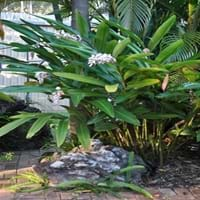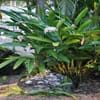Life Span
Perennial
Perennial
Type
Tender Perennial
Flowering Plants, Fruits, Trees
Origin
Southeastern Asia, India, Melanesia, Micronesia
Anatolia, Asia, Europe, Iran, Maghreb, Morocco, Norway, The Hiamalayas
Types
Variegata Dwarf, Variegata Chinese Beauty
Flowering Cherries, Sour Cherries, Sand Cherries, Sweet Cherries, Capulin Cherries
Number of Varieties
Not Available
Habitat
Tropical regions
Forest edges, Wild, Woods
USDA Hardiness Zone
8-15
4-8
Sunset Zone
H1, H2, 14, 15, 16, 17, 18, 19, 20, 21, 22, 23, 24
4, 5, 6, 7, 15, 16, 17
Habit
Clump-Forming
Upright/Erect
Flower Color
White, Red, Light Pink
White
Flower Color Modifier
Multi-Color
Not Available
Fruit Color
Not Available
Red
Leaf Color in Spring
Dark Green
Dark Green
Leaf Color in Summer
Dark Green
Orange
Leaf Color in Fall
Dark Green
Orange
Leaf Color in Winter
Dark Green
Orange
Leaf Shape
Lance shaped
Oblong
Plant Season
Spring, Summer, Fall, Winter
Spring, Summer
Sunlight
Partial Sun, Partial shade
Full Sun, Partial shade
Type of Soil
Loam, Sand
Loamy, Well drained
The pH of Soil
Acidic, Neutral
Slightly Acidic
Soil Drainage
Average
Average
Bloom Time
Late Spring, Early Summer, Summer
Early Spring, Spring
Tolerances
Drought
Heat And Humidity, Not Available
Where to Plant?
Container, Ground, Pot
Ground
How to Plant?
By dividing rhizomes, tubers
Grafting, Seedlings, Transplanting
Plant Maintenance
Medium
Medium
Watering Requirements
Requires plenty of water during the growing season
Never Over-water, Over-watering can cause leaf problems or root diseases, Prefer drip-irrigation instead of Over-head watering, Water twice a day in the initial period
In Summer
Lots of watering
Lots of watering
In Spring
Moderate
Moderate
In Winter
Average Water
Average Water
Soil pH
Acidic, Neutral
Slightly Acidic
Soil Type
Loam, Sand
Loamy, Well drained
Soil Drainage Capacity
Average
Average
Sun Exposure
Partial Sun, Partial shade
Full Sun, Partial shade
Pruning
Cut off the flower stalks at the base of the plant, Remove dead leaves, Remove dead or diseased plant parts
Don't prune in the fall, Prune if you want to improve plant shape, Prune in late winter, Remove dead or diseased plant parts, Remove deadheads
Fertilizers
Apply 8-4-6 amount
All-Purpose Liquid Fertilizer
Pests and Diseases
No serious insect or disease problems
Aphids, Bacterial Canker, Black Knot, Brown Rot, Caterpillars
Plant Tolerance
Drought
Drought
Flower Petal Number
Single
Not Available
Fragrant Bark/Stem
Yes
No
Foliage Texture
Coarse
Not Available
Foliage Sheen
Glossy
Not Available
Attracts
Butterflies, Not Available
Birds
Allergy
Rash
Swelling in the face
Aesthetic Uses
Showy Purposes
Showy Purposes
Beauty Benefits
Good for skin
Not Available
Environmental Uses
Air purification
Air purification
Medicinal Uses
Antiulcerogenic, Diuretic, Hypotensive
Arthritis, Gout, Kidney problems, Rheumatoid arthritis, Swelling
Part of Plant Used
Leaves, Rhizomes
Flowers, Fruits
Other Uses
Can be made into a herbal tea, Leaves used for wrapping zongi, Used to flavour noodles, Used to wrap mochi rice cakes
Wood is used for making furniture
Used As Indoor Plant
Yes
No
Used As Outdoor Plant
Yes
Yes
Garden Design
Container, Cutflower, Mixed Border, Screening / Wind Break, Tropical
Not Available
Botanical Name
ALPINIA zerumbet
Prunus avium
Common Name
Shell Ginger
Cherry Tree
In Hindi
Shell Ginger
चेरी का पेड़
In German
Shell Ginger
Kirschbaum
In French
Shell Ginger
Cerisier
In Spanish
Shell jengibre
Cerezo
In Greek
Shell Τζίντζερ
κερασιά
In Portuguese
Shell Ginger
árvore de cereja
In Polish
Shell Imbir
wiśniowe drzewo
In Latin
Crusta Ginger
Cherry
Phylum
Magnoliophyta
Magnoliophyta
Class
Lilopsida
Magnoliopsida
Order
Zingiberales
Rosales
Family
Zingiberaceae
Rosaceae
Clade
Angiosperms, Commelinids, Monocots
Angiosperms, Eudicots, Rosids
Tribe
Alpinieae
Not Available
Subfamily
Alpinioideae
Not Available
Number of Species
Not Available
Not Available
Season and Care of Shell Ginger and Cherry Tree
Season and care of Shell Ginger and Cherry Tree is important to know. While considering everything about Shell Ginger and Cherry Tree Care, growing season is an essential factor. Shell Ginger season is Spring, Summer, Fall and Winter and Cherry Tree season is Spring, Summer, Fall and Winter. The type of soil for Shell Ginger is Loam, Sand and for Cherry Tree is Loamy, Well drained while the PH of soil for Shell Ginger is Acidic, Neutral and for Cherry Tree is Slightly Acidic.
Shell Ginger and Cherry Tree Physical Information
Shell Ginger and Cherry Tree physical information is very important for comparison. Shell Ginger height is 180.00 cm and width 120.00 cm whereas Cherry Tree height is 17.50 cm and width 17.50 cm. The color specification of Shell Ginger and Cherry Tree are as follows:
Shell Ginger flower color: White, Red and Light Pink
Shell Ginger leaf color: Dark Green
Cherry Tree flower color: White
- Cherry Tree leaf color: Dark Green
Care of Shell Ginger and Cherry Tree
Care of Shell Ginger and Cherry Tree include pruning, fertilizers, watering etc. Shell Ginger pruning is done Cut off the flower stalks at the base of the plant, Remove dead leaves and Remove dead or diseased plant parts and Cherry Tree pruning is done Don't prune in the fall, Prune if you want to improve plant shape, Prune in late winter, Remove dead or diseased plant parts and Remove deadheads. In summer Shell Ginger needs Lots of watering and in winter, it needs Average Water. Whereas, in summer Cherry Tree needs Lots of watering and in winter, it needs Average Water.





